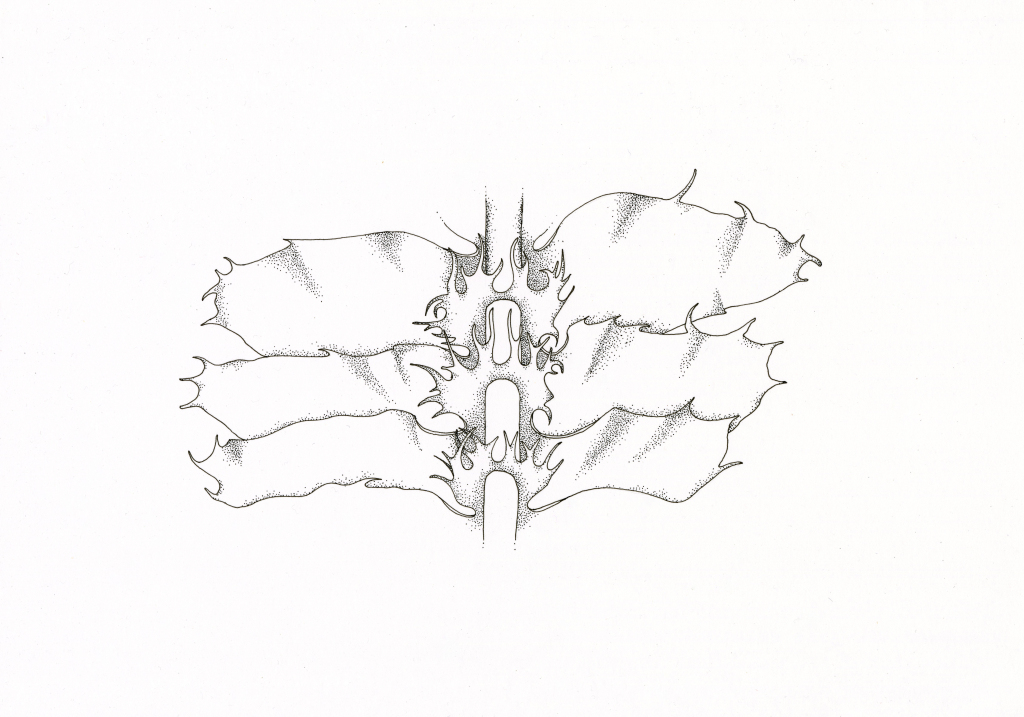Heteroscyphus
Terrestrial, lithophytic and epiphytic, dioicous or monoicous (not in Victoria). Asexual reproduction absent. Stems irregularly branched; branches emerging from main stem near to abaxial side of lateral leaf with or without a collar of tissue at its base, or emerging from near underleaves and with a collar of tissue at base. Lateral leaves ovate to oblong, unlobed or rarely bilobed, entire or with 1–several teeth around the margins, alternate to opposite, convex or rarely concave (not in Victoria) adaxially, with succubous insertion, extending to stem midline adaxially or not extending to stem midline adaxially, leaving a leaf-free strip of 1–11 cell rows between it and leaf on opposite side of stem, distant to imbricate. Underleaves longer than broad with two main triangular lobes, with or without (not in Victoria) additional teeth or lobes on either side, or broader than wide and reniform in outline, with 2–multiple teeth or lobes or rarely entire (not in Victoria), wider or rarely slightly narrower (not in Victoria) than stem, narrowly to broadly connate to both nearest lateral leaves, narrowly or broadly connate with lateral leaf with acroscopic margin closest to underleaf, free from other lateral leaf, or rarely completely free from lateral leaves (not in Victoria), distant to imbricate, plane to concave or convex (not in Victoria) when viewed from below. Leaf cells circular, elliptic or polygonal, smooth, faintly papillose or with 1–several cell spine-like projections, thin-walled, with or rarely without (not in Victoria) distinct trigones, with 1–13 finely granular to botryoidal ellipsoid, ovoid or fusiform oil bodies. Androecia on short branches lacking normal vegetative leaves emerging from main stem near lateral leaves. Perianth on short branches lacking normal vegetative leaves emerging from main stem near lateral leaves or underleaves, rarely terminal on main stem, trigonous, urceolate, ovaoid, ellipsoid, obloid or cylindric, inflated, divided into three lobes at apex with entire to dentate, laciniate or ciliate margins.
Ninety-eight species mostly in Australasia but extending north to Japan, and also in the Pacific, Andes and southern South America, central to southern Africa, and Tristan da Cunha (Söderström et al. 2016; Engel & Glenny 2019); nine species in Victoria.
The species currently assigned to Heteroscyphus that have been included in phylogenies of DNA sequences form the most basally diverging lineages in the Lophocoleaceae and do not form a single lineage (Hentschel et al. 2006). This suggests that Heteroscyphus may require division. However, the sample of species used in phylogenies to date is still far from comprehensive and representative of the large morphological variation present within Heteroscyphus. Any revision of this genus will require more clear elucidation of relationships within this genus and to other Lophocoleaceae that can be only achieved with a greater sampling of species.
Most of the Victorian species of Heteroscyphus were confusingly treated as Chiloscyphus Corda in Scott (1985), while the Victorian Chiloscyphus species were treated as Lophocolea Dumort.
Engel, J.J. & Glenny, D. (2019). A Flora of the Liverworts and Hornworts of New Zealand, volume 2. Missouri Botanical Garden Press: St Louis.
Hentschel, J., Wilson, R., Burghardt, M., Zündorf, H.-J., Schneider, H. & Heinrichs, J. (2006). Reinstatement of Lophocoleaceae (Jungermanniopsida) based on chloroplast gene rbcL data: exploring the importance of female involucres for the systematics of Jungermanniales. Plant Systematics and Evolution 258: 211–226.
Scott, G.A.M. (1985). Southern Australian Liverworts. Australian Government Publishing Service: Canberra.
Söderström, L., Hagborg, A., von Konrat, M., Bartholomew-Began, S., Bell, D., Briscoe, L., Brown, E., Cargill, D.C., Costa, D.P., Crandall-Stotler, B.J., Cooper, E.D., Dauphin, G., Engel, J.J., Feldberg, K., Glenny, D., Gradstein, S.R., He, X., Heinrichs, J., Hentschel, J., Ilkiu-Borges, A.L., Katagiri, T., Konstantinova, N.A., Larraín, J., Long, D.G., Nebel, M., Pócs, T., Puche, F., Reiner-Drehwald, E., Renner, M.A.M., Sass-Gyarmati, A., Schäfer-Verwimp, A., Moragues, J.S., Stotler, R.E., Sukkharak, P., Thiers, B.M., Uribe, J., Váňa, J., Villarreal, J.C., Wigginton, M., Zhang, L. & Zhu, R. (2016). World checklist of hornworts and liverworts. Phytokeys 59: 1–828.
 Spinning
Spinning